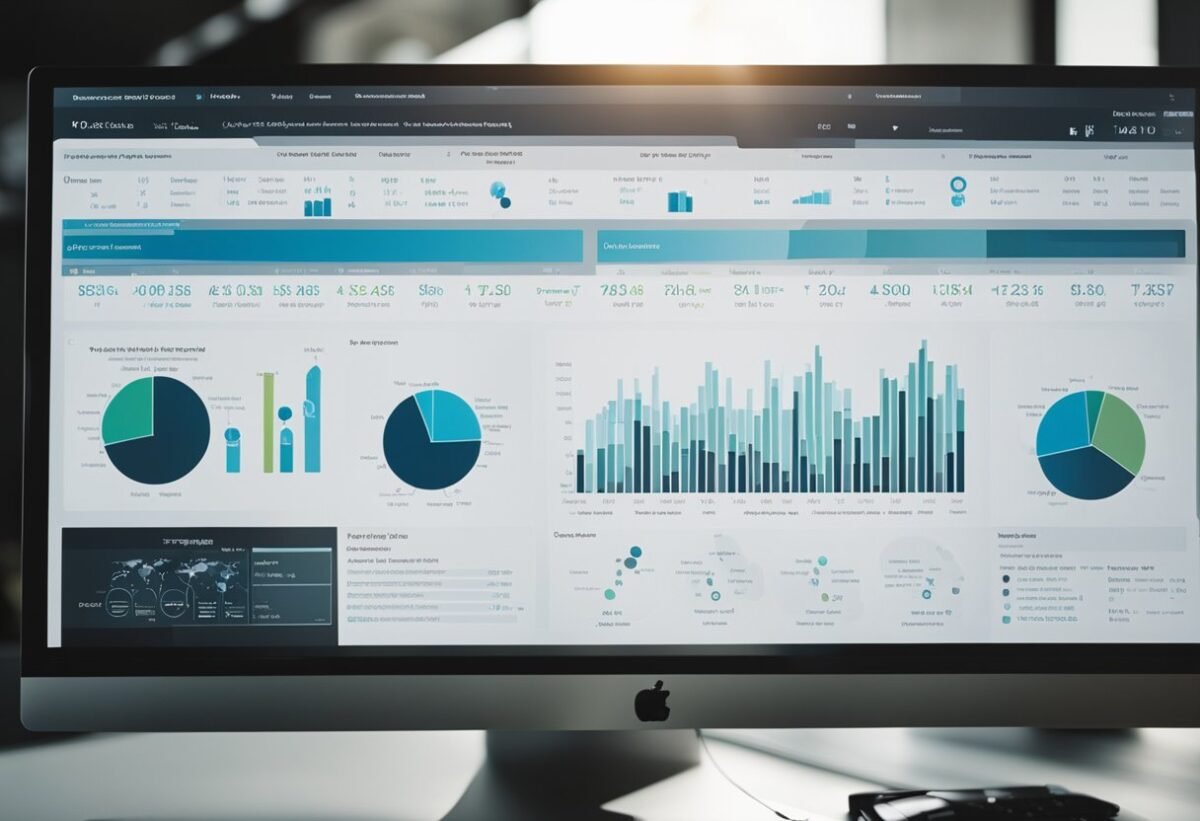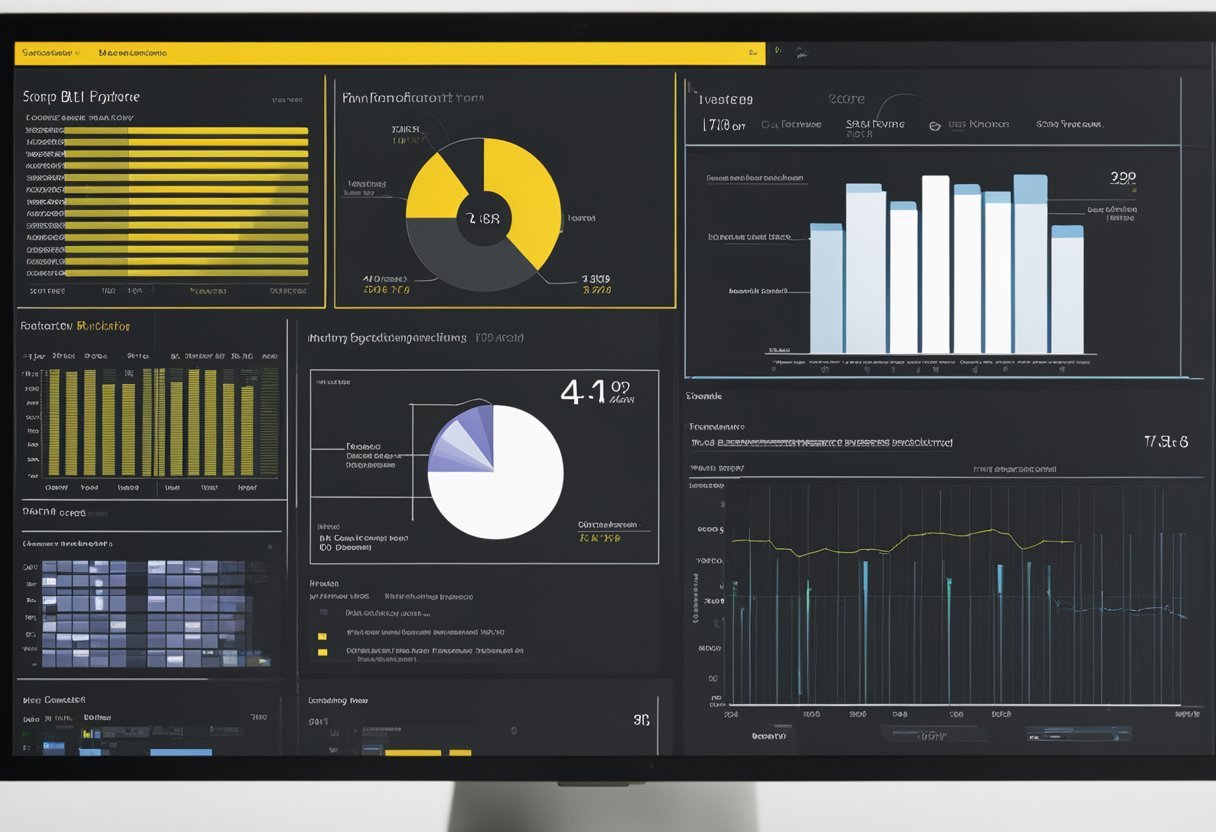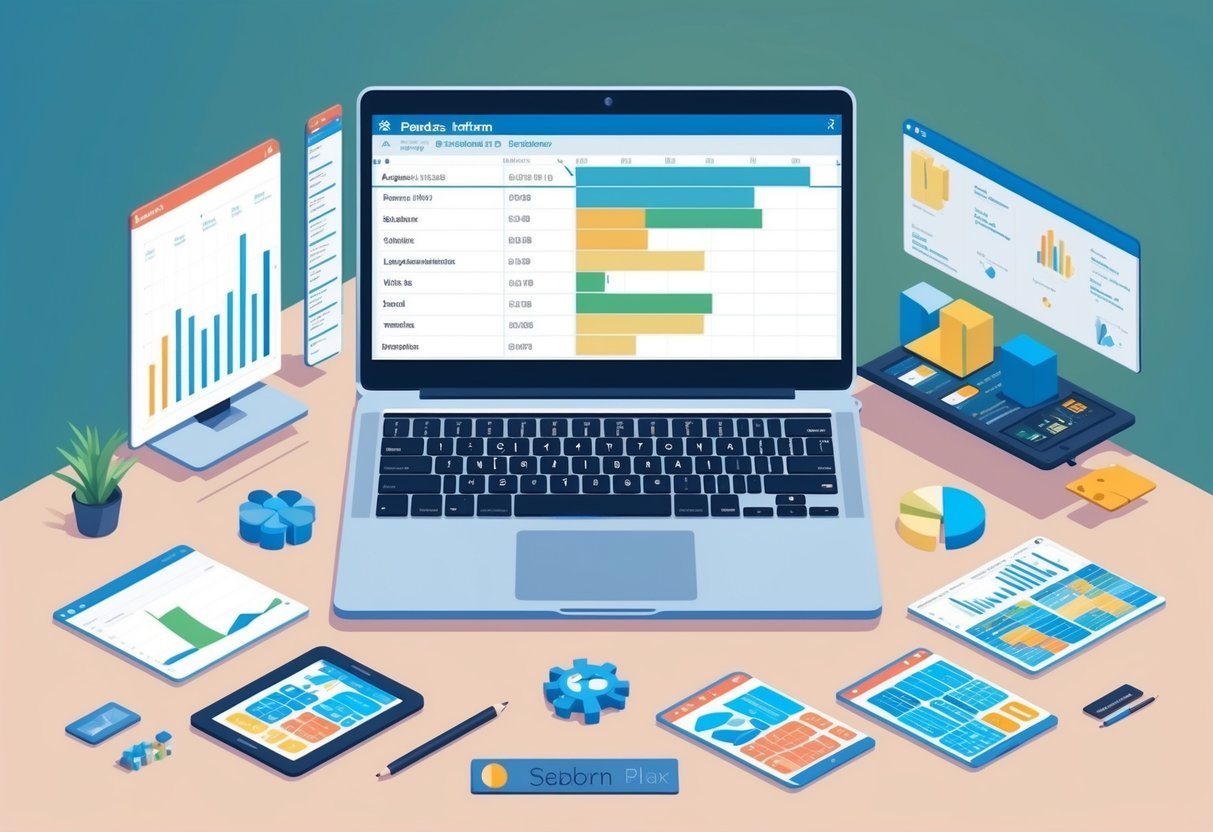Understanding Linear Algebra Fundamentals
Linear algebra is crucial for data science, providing tools to manipulate data in efficient ways.
Mastery of vectors, matrices, and transformations forms the backbone for many algorithms and techniques in the field.
This section explores essential concepts that enable deeper insights into computational methods used in data science.
Vectors and Matrices
Vectors are one-dimensional arrays used to represent data points or coordinates in space. They serve as basic building blocks in linear algebra and are essential for defining spaces and directions.
Matrices are an extension of vectors into two dimensions, consisting of rows and columns. These rectangular arrays are used to perform operations such as transformations and are pivotal for linear mappings between different spaces.
A key property of matrices is their ability to transform vectors by scaling, rotating, or translating them.
In data science, matrices simplify complex calculations, making them fundamental in machine learning models.
Concepts like addition, multiplication, and inverse of matrices are essential for efficient data manipulation.
Linear Transformations
Linear transformations are functions that map vectors to other vectors in a linear manner. These transformations preserve operations like vector addition and scalar multiplication.
Utilizing matrices, linear transformations are a cornerstone of data science because they provide a framework to perform operations like dimensionality reduction. This process simplifies data while retaining essential features, crucial for analysis and visualization.
Transformations can also represent rotations and scaling in various applications, simplifying complex operations in image processing and computer graphics.
Understanding these transformations expands the capability to manipulate and analyze large datasets effectively.
Dot Product and Orthogonality
The dot product is an operation that takes two vectors and returns a scalar. It measures the extent to which two vectors point in the same direction, providing insight into their alignment.
When the dot product is zero, the vectors are orthogonal, meaning they are at a right angle to each other.
This property is significant in optimizing data science algorithms. Orthogonal vectors simplify calculations, making operations like projections and decompositions more efficient.
In practical applications, the dot product is used for measuring similarity between vectors, which is critical in various algorithms, including those for recommendations or clustering.
Eigenvalues and Eigenvectors
Eigenvalues and eigenvectors are pivotal in understanding matrix transformations. For a given matrix, eigenvectors indicate directions that remain unchanged by the transformation, while eigenvalues represent the scale of change along those directions.
These concepts are particularly important in Singular Value Decomposition, used commonly in data reduction and noise reduction.
They help to identify intrinsic properties of datasets and are essential in fields like machine learning, where they aid in simplifying models.
Together, eigenvalues and eigenvectors enable powerful techniques such as Principal Component Analysis (PCA), enhancing the ability to interpret complex datasets and extract meaningful patterns.
Breaking Down Singular Value Decomposition
Singular Value Decomposition (SVD) is an essential tool in linear algebra, breaking down complex matrices into more manageable parts. It reveals information about the structure of data and finds important applications in machine learning and data science.
Definition of Singular Value Decomposition
SVD is a method of decomposing a matrix into three other matrices. If one has a matrix ( A ), SVD expresses it as ( A = U \Sigma V^T ).
- ( U ): Contains the left singular vectors.
- ( \Sigma ): A diagonal matrix with singular values.
- ( V^T ): Contains the right singular vectors.
Each part contributes to the representation of the original data, with singular values indicating the significance of each dimension.
Geometric Interpretation
Understanding the geometric side of SVD helps in grasping its impact on data transformations.
The left singular vectors (( U )) can be seen as an orthogonal basis for the column space of ( A ).
The right singular vectors (( V )) offer an orthogonal basis for the row space. Singular values in ( \Sigma ) scale and rotate these vectors in geometric space, modifying the shape of data.
This geometric view shows how SVD compresses and alters data, useful in reducing noise and dimensionality.
Singular Values and Singular Vectors
Singular values in SVD are key to understanding any matrix’s structure. They are ordered by magnitude, with larger values having a more significant effect on the data’s dimensionality.
Left singular vectors (( U )) and right singular vectors (( V )) are orthogonal sets, providing directions of variance in the data. These vectors help reconstruct the original matrix when combined with singular values.
By keeping only the largest singular values and vectors, one can effectively approximate the matrix, highlighting the most important features.
This approximation is widely used in practices like data compression and noise reduction in various applications such as image and signal processing.
Matrix Decomposition Techniques
Matrix decomposition is essential in linear algebra, offering ways to break matrices into simpler parts. This process helps in various computations and applications in data science by simplifying complex matrix operations.
Comparing SVD and Eigen Decomposition
Singular Value Decomposition (SVD) and eigen decomposition are both vital techniques in matrix analysis.
SVD decomposes a matrix into three matrices: U, Σ, and V*, where U and V* are orthogonal matrices, and Σ is a diagonal matrix. This decomposition is widely used in image compression and noise reduction.
In contrast, eigen decomposition splits a square matrix into eigenvectors and eigenvalues, requiring the matrix to be square. It expresses the matrix as a product of its eigenvectors and a diagonal matrix of its eigenvalues.
While SVD can be applied to any rectangular matrix, eigen decomposition is specific to those that are square.
Orthogonal and Diagonal Matrix Decomposition
Orthogonal matrices feature prominently in matrix decomposition techniques. In such matrices, rows and columns are orthogonal unit vectors. They are used in SVD for stable and accurate calculations due to their properties that preserve angles and lengths during transformations.
Diagonal matrix decomposition occurs when a matrix is expressed with a diagonal matrix, which has non-zero elements only on its main diagonal.
Diagonal matrices are easy to compute with, making them valuable in various applications, including simplifying complex linear transformations. Their straightforward nature aids in efficient calculations and interpretations of linear models in data science.
Numerical Computing with Python
Numerical computing in Python plays a crucial role in data science, allowing for efficient calculations and matrix operations. Singular Value Decomposition (SVD) can be implemented seamlessly using Python libraries, enabling data scientists to handle large datasets effectively.
Utilizing NumPy for Matrix Operations
NumPy is the fundamental library for numerical computing in Python.
It provides support for array and matrix operations, which are essential for data science tasks.
Its array object, known as ndarray, optimizes storage by requiring fewer bits for each data point, thus speeding up computations.
Operations like matrix multiplication, addition, and subtraction are easily performed using NumPy. These operations simplify tasks such as linear transformations and data manipulation.
Additionally, NumPy’s ability to handle large datasets efficiently makes it indispensable for data analytics tasks, especially when dealing with high-dimensional data.
NumPy also offers a range of mathematical operations on matrices, such as reductions, broadcasting, and linear algebra functions.
Features like these make NumPy a preferred choice among data scientists and computational mathematicians.
Python Implementation of SVD
Singular Value Decomposition (SVD) can be implemented in Python using NumPy’s linear algebra module.
The function numpy.linalg.svd(a) decomposes a given matrix a into three matrices: U, Σ, and Vᵀ, representing the singular vectors and singular values.
Implementing SVD in Python helps in dimensions reduction, noise reduction, and data compression.
These capabilities are vital when working with large datasets or image processing tasks.
By reducing the matrix dimensions, SVD helps in focusing on the relevant features, thus helping in efficient computation.
Python’s clear syntax, combined with NumPy’s capabilities, offers a robust toolset for performing SVD. This enables rapid prototyping and testing, making it easier for data scientists to work effectively with complex datasets.
Applications in Data Science and Machine Learning
Linear algebra plays a crucial role in data science and machine learning. It is used extensively in techniques like dimensionality reduction that streamline computations, image compression that maintains quality while saving space, and noise reduction that enhances data clarity. Understanding these applications helps in leveraging data more effectively.
Dimensionality Reduction Techniques
Dimensionality reduction is essential in data science for simplifying complex data sets. Techniques like Principal Component Analysis (PCA) and Singular Value Decomposition (SVD) are pivotal.
These methods transform large datasets into smaller ones without losing critical information.
By reducing the number of variables, they help speed up algorithms and improve performance.
SVD, for example, decomposes matrices to identify underlying structures. This approach is especially useful in fields with high-dimensional data like genomics and bioinformatics. It not only enhances computation but also aids in visualizing complex data structures, making patterns more discernible.
Image Compression and Reconstruction
Image compression benefits significantly from linear algebra techniques.
SVD reduces the dimensions of image data by identifying the most important features and discarding less crucial information. This results in smaller file sizes while preserving essential image details.
For example, JPEG compression uses such methods to maintain image quality within reduced space.
In image compression, the matrix structure of images is analyzed and simplified, effectively lowering storage costs and transmission times. When needed, these images can be reconstructed with minimal loss, making these techniques invaluable for digital media, medical imaging, and video streaming industries.
Noise Reduction in Data
Noise reduction enhances the clarity and usability of data. In data science, noise refers to irrelevant or random data that obscures meaningful information.
Techniques like SVD help identify and filter out this noise.
By analyzing data for patterns and discerning noise, these techniques improve the precision of predictive models.
SVD isolates the main signals within a dataset, allowing machine learning models to function more reliably and efficiently. This method is widely used in fields like finance and sensor data analysis, where accuracy is paramount. It ensures that predictions and insights drawn from the data are as clear and accurate as possible.
Advanced SVD: Beyond the Basics
Singular Value Decomposition (SVD) provides a powerful method for analyzing matrices, offering insights into complex mathematical concepts and applications. Key topics in advanced SVD include orthogonal and orthonormal eigenvectors, and how SVD handles non-square matrices.
Orthogonal and Orthonormal Eigenvectors
Orthogonal and orthonormal eigenvectors are crucial in understanding SVD’s role in data science.
In simpler terms, orthogonal eigenvectors maintain independence, ensuring each vector stands at a right angle to the others. This independence is vital for the effective decomposition of matrices, leading to more accurate data representation.
Orthonormal eigenvectors take this a step further by being both orthogonal and having a unit length. This combination allows SVD to efficiently compute solutions, often simplifying complex calculations.
The properties of orthonormal vectors make them ideal for use in algorithms that require matrix factorization, such as principal component analysis (PCA).
Example: In an orthogonal matrix, each row is an orthogonal eigenvector, resulting in simplified mathematical operations.
Handling Non-Square Matrices
SVD is unique in its ability to work with non-square matrices, a common occurrence in real-world data analysis. This adaptability allows SVD to decompose any matrix into three parts, regardless of initial shape.
Each of these matrices offers insights into different characteristics of the original matrix. By dealing with non-square matrices, SVD ensures that even datasets with irregular dimensions can be handled effectively.
This capability is crucial in applications like image processing and data compression.
Practical Implementation in Libraries
For those diving into data science, singular value decomposition (SVD) is an essential tool for simplifying complex matrices. Many popular libraries, such as NumPy, offer straightforward methods to apply SVD, making it accessible for both beginners and experienced users.
Leveraging SVD in NumPy
NumPy is a widely used library in Python for numerical computations. It provides efficient tools to perform SVD on large datasets.
The function numpy.linalg.svd() can decompose a matrix into its singular values and vectors with ease. Users can specify whether they want full or reduced decomposition, depending on their computational needs.
Here’s a basic example of using SVD in NumPy:
import numpy as np
# Create a random matrix
A = np.random.rand(4, 3)
# Perform SVD
U, S, Vt = np.linalg.svd(A)
# Display the results
print("U matrix:\n", U)
print("Singular values:\n", S)
print("V transpose:\n", Vt)
This code snippet demonstrates how NumPy makes it straightforward to perform SVD, yielding matrices U, S, and VT</sup. These components are crucial for further data analysis tasks like dimensionality reduction or noise reduction in datasets. Utilizing NumPy for SVD can greatly simplify working with complex linear algebra problems in data science.
Principal Component Analysis (PCA)
Principal Component Analysis (PCA) is a technique used in data science to reduce the dimensionality of sizable datasets. It transforms data to uncover patterns and highlight similarities. PCA is closely related to Singular Value Decomposition (SVD) and is widely used for feature extraction and data compression.
Understanding PCA
PCA is a statistical method that transforms high-dimensional data into a lower-dimensional format. This process retains the essential variance of the original data, making it easier to analyze and visualize.
At its core, PCA finds new variables, called principal components, which are linear combinations of the original features.
These principal components are orthogonal to each other, meaning they do not overlap in the information they represent. The first principal component accounts for the most variance, while each subsequent component captures the remaining variance in decreasing order.
This transformation helps reduce noise and makes it easier to identify patterns, acting as a foundation for many machine learning methods.
PCA vs. SVD
PCA and SVD are powerful tools in linear algebra used for dimensionality reduction. Both techniques aim to simplify complex data structures, but they differ slightly in their approaches.
SVD decomposes a matrix into three distinct matrices, helping derive features or compress the data. PCA, on the other hand, involves calculating the covariance matrix, followed by extracting eigenvectors and eigenvalues to identify the principal components.
While the mathematical processes are related, their purposes can diverge. PCA is typically preferred for data analysis and visualization, while SVD is more often applied in computational methods like image compression. For more on the relationship between these methods, see how SVD aids in performing PCA in this discussion.
PCA for Feature Extraction
PCA is a valuable tool for feature extraction, capturing the most relevant aspects of data. By selecting the principal components that represent the majority of the data’s variance, PCA reduces the dimensionality while preserving the critical features.
It sifts through noise and redundancy, highlighting the data’s most informative parts.
This feature extraction method makes PCA ideal for many applications, such as improving the efficiency and performance of machine learning models.
By focusing on important components, PCA allows for more efficient data processing and can significantly enhance model training and prediction accuracy. This application is discussed in detail in the context of dimensionality reduction in this guide.
Matrix Factorization in Collaborative Filtering
Matrix factorization is a key technique in collaborative filtering used in recommender systems. It breaks down large user-item data into simpler matrices, revealing hidden patterns and relationships. This technique is powerful for handling sparse data and improving prediction accuracy.
Recommender Systems and SVD
Recommender systems often utilize Singular Value Decomposition (SVD) for matrix factorization. SVD decomposes a user-item matrix into three smaller matrices, which helps capture latent features. These features reveal the similarities between users and items beyond explicit ratings.
One practical application is movie recommendation. Using SVD, the system can effectively predict user preferences by analyzing both direct and indirect interactions. This method enhances the recommendation’s personalization and accuracy.
For developers interested in implementing SVD, resources like Google for Developers offer practical insights on matrix factorization. Understanding these concepts can greatly contribute to the development of more efficient and accurate recommender systems.
Understanding Matrix Spaces
Matrix spaces are crucial concepts in linear algebra. Knowing about the null space and the identity matrix helps in understanding how matrices function, especially when dealing with linear transformations and systems of equations. These elements are essential for data science applications and computational tasks.
Null Space and Its Implications
The null space of a matrix includes all vector solutions to the equation (Ax = 0). When a matrix, (A), is multiplied by the vector (x), and results in a zero vector, then (x) is part of the null space.
A matrix’s null space is important for determining if systems of equations have solutions. If the null space is only the zero vector, the system has a unique solution. More elements in the null space suggest infinite solutions.
Understanding the null space is key for reducing data dimensions, essential in fields like image processing and compression. It allows identifying redundant data by determining which inputs can be reduced while maintaining core functionality.
Role of Identity Matrix
The identity matrix, often denoted as (I), is a matrix equivalent to 1 in scalar numbers. Multiplying any matrix (A) by an identity matrix leaves (A) unchanged, i.e., (AI = IA = A). This property makes the identity matrix essential for preserving information during calculations.
It’s usually used in matrix inversion and solving linear equation systems to transform matrices without altering their properties. The identity matrix acts as a pivot in matrix operations like row reduction and comes up often when applying transformations.
The size of an identity matrix matches the dimensions of the matrices it interacts with, making it a flexible tool. Its simplicity belies its importance in maintaining matrix stability and function during complex operations.
Graphical Representation of Matrices
Matrices offer versatile ways to represent and manipulate visual data. They can be used to model transformations such as rotation and scaling and can interpret grayscale images as arrays of numbers.
Visualizing Rotation and Scaling
Matrices are powerful tools for representing geometric transformations. For example, a rotation matrix is used to rotate points in a plane around the origin. This rotation is expressed mathematically, with the matrix determining the angles of rotation.
Similarly, scaling matrices are used to change the size of objects. The matrix entries adjust the dimensions, either enlarging or shrinking an object. This can be seen in computer graphics where rotating and scaling visual objects are essential for animation and design, providing a precise and numerical way to achieve these effects.
Interpreting Grayscale Images as Matrices
Grayscale images can be represented as matrices where each pixel corresponds to an entry. Each number in the matrix represents the intensity of the grayscale.
This allows for analyzing and processing images through mathematical operations. For example, manipulating these matrices can enhance image quality or extract important features.
Grayscale matrices are crucial in fields like image compression and computer vision. By viewing images as matrices, complex image processing techniques become accessible, enabling tasks such as edge detection or filtering. This matrix interpretation opens the door to numerous applications in image analysis and machine learning, where data is frequently visualized and interpreted as arrays of numbers.
Optimized Computing for Large Datasets
The efficient handling of large datasets can be achieved using techniques like Singular Value Decomposition (SVD). These methods help in data compression and matrix approximation to improve computation speed.
Speeding Up SVD Computations
Singular Value Decomposition is a powerful tool for breaking down large matrices. It allows for efficient data compression by retaining the most critical information in a smaller form.
This is particularly important in fields like machine learning and data science where handling vast matrices is common.
To speed up SVD computations, practitioners often use optimized algorithms and hardware acceleration. These approaches reduce computational load, making it possible to work with huge datasets quickly.
Matrix approximation techniques are also employed to simplify calculations. By focusing on the largest singular values, matrices can be approximated with lower rank representations, reducing size without significant loss of information.
These improvements in computation enable more scalable and effective processing of data, leading to enhanced performance in various applications.
Frequently Asked Questions
Singular Value Decomposition (SVD) is an essential tool in linear algebra used in data science and machine learning. It helps with tasks like dimensionality reduction and data compression.
What are the practical applications of Singular Value Decomposition in data science?
In data science, SVD is used for dimensionality reduction, which simplifies data sets without losing important information. It’s commonly applied in image compression and noise reduction. By breaking down complex data into simpler parts, SVD allows data scientists to handle large data sets more efficiently.
How is Singular Value Decomposition utilized in machine learning?
In machine learning, SVD aids in preprocessing data by reducing dimensionality, which can improve the performance of algorithms. It helps in identifying patterns and compressing data, making it beneficial for tasks such as feature extraction and data visualization. SVD is especially useful in recommendation systems and natural language processing.
Can you explain Singular Value Decomposition with a 3×3 matrix example?
Consider a 3×3 matrix A. SVD breaks it down into three matrices: U, S, and V^T. U and V^T are orthogonal matrices, and S is a diagonal matrix containing singular values. These matrices reveal important properties, such as the principal components, of the original matrix SVD breakdown.
What are the steps to perform Singular Value Decomposition on a 2×3 matrix?
To perform SVD on a 2×3 matrix, start by finding the eigenvalues and eigenvectors of the matrix. Use these to construct the matrices U and V^T, ensuring they are orthogonal. Next, place the singular values, which are the square roots of the eigenvalues, into S, completing the decomposition.
Where can I find resources or a PDF that explains Singular Value Decomposition in detail?
Online educational platforms and websites like GeeksforGeeks and Machine Learning Plus provide detailed explanations of SVD.
These resources include theoretical insights as well as practical examples. They are often available in downloadable formats.
How does one interpret the results of Singular Value Decomposition in the context of data analysis?
In data analysis, the decomposition of a matrix using SVD reveals insights into the importance of different dimensions.
Singular values in S show the strength of each dimension in the original data. Analysts use these values to determine which dimensions can be reduced without significant loss of information.





























